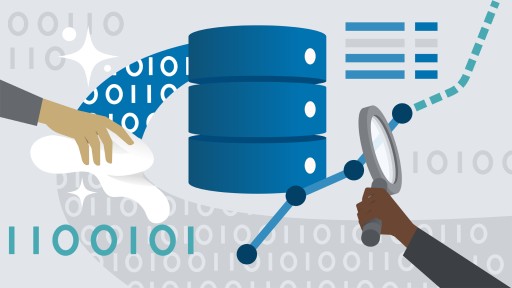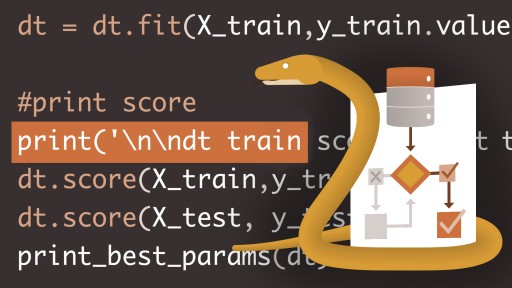
Azure Databricks is a cloud-scale platform for data analytics and machine learning. Data scientists and machine learning engineers can use Azure Databricks to implement machine learning solutions at scale.
Prerequisites
This learning path assumes that you have experience of using Python to explore data and train machine learning models with common open source frameworks, like Scikit-Learn, PyTorch, and TensorFlow.

Explore the capabilities of Microsoft Fabric.
Prerequisites
You should be familiar with basic data concepts and terminology.

This course covers methods and practices for implementing and managing enterprise-scale data analytics solutions using Microsoft Fabric. Students will learn how to use Fabric dataflows, pipelines, and notebooks to develop analytics assets such as semantic models, data warehouses, and lakehouses. This course is designed for experienced data professionals skilled at data preparation, modeling, analysis, and visualization, such as the PL-300: Power BI Data Analyst certification.
The primary audience for this course is data professionals with experience in data modeling and analytics. DP-600 is designed for professionals who want to use Microsoft Fabric to create and deploy enterprise-scale data analytics solutions. Learners should have prior experience with one of the following programming languages: Structured Query Language (SQL), Kusto Query Language (KQL), or Data Analysis Expressions (DAX).

This course covers methods and practices to implement data engineering solutions by using Microsoft Fabric. Students will learn how to design and develop effective data loading patterns, data architectures, and orchestration processes. Objectives for this course include ingesting and transforming data and securing, managing, and monitoring data engineering solutions. This course is designed for experienced data professionals skilled at data integration and orchestration, such as those with the DP-203: Azure Data Engineer certification.
This audience for this course is data professionals with experience in data extraction, transformation, and loading. DP-700 is designed for professionals who need to create and deploy data engineering solutions using Microsoft Fabric for enterprise-scale data analytics. Learners should also have experience at manipulating and transforming data with one of the following programming languages: Structured Query Language (SQL), PySpark, or Kusto Query Language (KQL).

Learn how to harness the power of Apache Spark and powerful clusters
running on the Azure Databricks platform to run large data engineering
workloads in the cloud.

Course duration: 1,7h
Data analytics revolutionized the way we work, and now, with the rise of artificial intelligence, data professionals have access to tools that let them work smarter and faster than ever before. In this beginner-friendly course, instructor Chris Dutton shows you have to leverage tools like Excel and ChatGPT together to work more efficiently and make smarter, data-driven decisions. Chris and the Maven Analytics team discuss how AI is revolutionizing data analysis, introduce the art of prompt engineering, review tips and best practices for generating consistent accurate model outputs, and address common limitations and pitfalls. Throughout the course you’ll learn some of the most powerful ChatGPT use cases for data science and analytics, and get hands-on practice using ChatGPT to explain and interpret code, generate formulas, troubleshoot errors, optimize complex queries, and much more.
Topics include:
This course is in French only. If this is not a problem for you, by all means go ahead and apply.

Course duration: 1,74h
Big data has transformed the world of business. Yet many people don't understand what big data and business intelligence are, or how to apply the techniques to their day-to-day jobs. This course addresses that knowledge gap, giving businesspeople practical methods to create quick and relevant business forecasts using big data. Join Professor Michael McDonald and discover how to use predictive analytics to forecast key performance indicators of interest, such as quarterly sales, projected cash flow, or even optimized product pricing. Learn how to gather, compute, and use basic financial ratios, and then how to apply those ratios for forecasting purposes looking at key outcomes for the firm. All you need is Microsoft Excel. Michael uses the built-in formulas, functions, and calculations to perform regression analysis, calculate confidence intervals, and stress test your results. You'll walk away from the course able to immediately begin creating forecasts for your own business needs.
Topics include:
- Identify strategies for using data to enhance business performance.
- Describe the steps in tying data to financial statements.
- Explain the reason for using ratios.
- Differentiate between various sources of data.
- Define the reason for using regression to make forecasts.
- Review the output of regression analysis in forecasting.
This course is in French only. If this is not a problem for you, by all means go ahead and apply.

Thinking about a career in data analytics or looking to land a more senior-level role? This course offers a friendly guide to landing a job in this in-demand field. Jess Ramos, a senior data analyst, helps you gauge your initial interest, providing her honest take on what entry-level and senior-level data analytics jobs entail and the amount of work it takes to land such a role. Once you determine whether your interests are a match for this field, Jess goes over the tools and skills you’ll need to excel as a data analyst, as well as how to advertise those skills on LinkedIn, make important connections, and land interviews. And to ensure that you ace those interviews, Jess explains how to build a data analytics portfolio that’s tailored to your target role and industry.
Topics include:
Deze cursus is enkel beschikbaar in het Engels. Als dit voor u geen probleem vormt, dien dan gerust uw aanvraag in.
This course is in French only. If this is not a problem for you, by all means go ahead and apply.

Course duration: 1,68h
Statistics are a core skill for many careers. Basic stats are critical for making decisions, discoveries, investments, and even predictions. But sometimes you need to move beyond the basics. This third course in the Statistics Foundations series gives you practical, example-based lessons on the intermediate skills associated with statistics: Samples and sampling, standard errors, confidence intervals, and hypothesis testing. Eddie Davila takes a look at topics like sampling, random samples, sample sizes, sampling error, trustworthiness, the central unit theorem, confidence intervals, and hypothesis testing. This course is a must for those working in data science, business, and business analytics—or anyone who wants to go beyond means and medians and gain a deeper understanding of how statistics work in the real world.
Topics include:
- Describe how non-representative samples can lead to biased conclusions in the context of polling.
- Recognize the characteristics and process of obtaining a convenience sample.
- Explain how concepts such as the law of large numbers and the central limit theorem are relevant to understanding the impact of sample size.
- Assess how confidence intervals contribute to the overall reliability and validity of election poll results.
- Discuss the role of test statistics in hypothesis testing and how they are used to find the p-value.
This course is in French only. If this is not a problem for you, by all means go ahead and apply.

Course duration: 2,57h
Want to accelerate your career in data science and analytics? Consider earning the Certified Analytics Professional (CAP) credential. This premier data science certification shows potential employers that you can glean insights from data and use your findings to determine logical next steps. In this course, Jungwoo Ryoo provides test takers with an understanding of how a core set of data science topics are relevant and necessary to obtain a CAP credential in an expedited fashion. Jungwoo covers the seven domains of the exam: business problem framing, analytics problem framing, data, methodology, model building, deployment, and lifecycle management. He also shares case studies that demonstrate how the CAP knowledge domain concepts work in the real world.
Topics include:
This course is in French only. If this is not a problem for you, by all means go ahead and apply.

Analytics is such a broad topic that it's hard to know where to get started. In this course designed for students, explore how to use data analytics to make informed decisions, and build core analytics skills that can prepare you to enter into the business or data science landscape. Learn about the basics of analytics, how data is typically captured, and how it impacts the day-to-day of a business. This course also provides an introduction to common tools used in analytics, as well as stories designed to help students get an overview of careers that require strong analytical skills.
Topics include:
Deze cursus is enkel beschikbaar in het Engels. Als dit voor u geen probleem vormt, dien dan gerust uw aanvraag in.
This course is in French only. If this is not a problem for you, by all means go ahead and apply.

CRISP-DM, the cross-industry standard process for data mining, is composed of six phases. Most new data scientists rush to modeling because it's the phase in which they have the most training. But whether the project succeeds or fails is actually determined far earlier. This course introduces a systematic approach to the data understanding phase for predictive modeling. Instructor Keith McCormick teaches principles, guidelines, and tools, such as KNIME and R, to properly assess a data set for its suitability for machine learning. Discover how to collect data, describe data, explore data by running bivariate visualizations, and verify your data quality, as well as make the transition to the data preparation phase. The course includes case studies and best practices, as well as challenge and solution sets for enhanced knowledge retention. By the end, you should have the skills you need to pay proper attention to this vital phase of all successful data science projects.
Topics include:
- Distinguishing data assessment from data viz
- Mastering the four data understanding tasks
- Collecting initial data
- Identifying the level of measurement
- Loading data
- Describing data
- Visualizing data
- Working with top predictors
- Using ggplot2 for data viz
- Verifying data quality
- Transitioning to data preparation
Deze cursus is enkel beschikbaar in het Engels. Als dit voor u geen probleem vormt, dien dan gerust uw aanvraag in.
This course is in French only. If this is not a problem for you, by all means go ahead and apply.

Nothing is more important to the future of predictive analytics teams than proving their projects have long-term value. Measuring the return on investment (ROI) often can help turn analytics into a visible profit center for your organization. Estimating ROI early—before a project even begins—can also help fast-track approval. Here Keith McCormick shows how to address ROI both before and after the predictive model is built. Learn how to create your estimate before the project starts by estimating the overall size of the problem, assigning value to possible outcomes, and judging the impact of model performance. Keith then shows a different method for calculating ROI after the model is built, during the evaluation and deployment phases, and provides tips for the ongoing monitoring of the project. He also takes a retrospective look assessed one year after model deployment. These two strategies will give you the data you need to get buy-in for your projects and provide ongoing metrics on their performance.
Topics include:
- Review the components of successful analytics in estimating and ensuring ROI.
- Identify types of statistical errors.
- Apply the confusion matrix to business decisions.
- Describe the reasoning in setting propensity score cutoff levels.
- Examine the process of monitoring predictive models.
Deze cursus is enkel beschikbaar in het Engels. Als dit voor u geen probleem vormt, dien dan gerust uw aanvraag in.
This course is in French only. If this is not a problem for you, by all means go ahead and apply.

It’s one thing to work with data. It’s another to provide quality data sets and accurate visualizations for decisions to be made. If you are considering a course emphasis or a career in data analytics, this course can help you get off to a good start. Robin Hunt, CEO and co-founder of ThinkData Solutions, shares practical skills to help you get the most from your data and jumpstart your career in data. Robin discusses business rules, filtering out the noise in the data we all deal with, and how to deliver what decision-makers want. She covers how to create data sets with queries, joins, and appends, then goes into building aggregate data with total queries. Robin goes over pivots, how to use pivots to build basic dashboards and visualizations, and how to use Power Query for data transformations. She concludes with best practices for meetings and taking your work to the next level for your organization.
Topics include:
- Explore concepts relating to data analytics.
- Explain the use of wildcard characters in building queries.
- Review types of data visualizations.
- Describe how slicers are used.
- Define terminology used in creating visualizations.
- Differentiate between duplicate and reference data sets.
- Identify licensing and permissions considerations.
Deze cursus is enkel beschikbaar in het Engels. Als dit voor u geen probleem vormt, dien dan gerust uw aanvraag in.
This course is in French only. If this is not a problem for you, by all means go ahead and apply.

KNIME is an open-source workbench-style tool for predictive analytics and machine learning. It is highly compatible with numerous data science technologies, including R, Python, Scala, and Spark. With KNIME, you can produce solutions that are virtually self-documenting and ready for use. These reasons and more make KNIME one of the most popular and fastest-growing analytics platforms around. In this course, expert Keith McCormick shows how KNIME supports all the phases of the Cross Industry Standard Process for Data Mining (CRISP-DM) in one platform. Get up and running quickly—in 15 minutes or less—or stick around for the more in-depth training covering merging and aggregation, modeling, and data scoring. Plus, learn how to increase the power of KNIME with extensions and integrate R and Python.
Topics include:
- Why use a workbench
- Why choose KNIME?
- Adding KNIME nodes with extensions
- Accessing data
- Exploring data statistically and visually
- Merging and aggregating data in KNIME
- Modeling in KNIME
- Scoring new data
- Combining KNIME with R and Python
Deze cursus is enkel beschikbaar in het Engels. Als dit voor u geen probleem vormt, dien dan gerust uw aanvraag in.
This course is in French only. If this is not a problem for you, by all means go ahead and apply.

Since the inception of data analytics, the way in which analysts view and interpret data has evolved tremendously. New technologies, tools, and approaches have advanced what's possible with data analytics, and network analysis is no exception. In this course, longtime data analyst and data visualization expert Heather Johnson shares the fundamentals of using graph analytics, or network analysis, when analyzing data. Heather begins by reviewing the components of a network analysis and detailing the advantages of using a graph analytics approach. She then walks through key applications of using graph analytics when reviewing data. To wrap up the course, Heather discusses career opportunities within the realm of graph analytics. Upon completion, you’ll be equipped with the knowledge of what graph analytics is and how it can be leveraged within your analytics career. This course was created by Madecraft. We are pleased to host this training in our library.
Topics include:
Deze cursus is enkel beschikbaar in het Engels. Als dit voor u geen probleem vormt, dien dan gerust uw aanvraag in.
This course is in French only. If this is not a problem for you, by all means go ahead and apply.

Data can tell many stories: where it came from and where it’s going. Predictive analytics gives programmers a tool to tell stories about the future: to extract usable information and make accurate predictions. These predictions, in turn, allow business to make more informed, impactful decisions. Join Isil Berkun, data scientist, to explore predictive analytics with Python. Discover how to prepare data—fill in missing values, perform feature scaling, and more—and use prebuilt Python libraries to make and evaluate prediction models. She describes what models to use when, and explains the concepts in such a way that you can immediately apply them to your own work. By the end of the course, you’ll be able to leverage Python libraries like pandas and NumPy and choose the right prediction models for your projects.
Topics include:
- Explain how predictive analytics can assist with decision-making.
- Differentiate between the types of data that are used.
- Apply the correct functions to Python code to produce optimal results.
- Explain why data needs to be preprocessed before using predictive models.
- Distinguish between the different predictive models available.
Deze cursus is enkel beschikbaar in het Engels. Als dit voor u geen probleem vormt, dien dan gerust uw aanvraag in.
This course is in French only. If this is not a problem for you, by all means go ahead and apply.

Many modern organizations have a wealth of data that they can draw from to inform their decisions. But all of this information can't truly benefit a business unless the professionals working with that data can efficiently extract meaningful insights from it. Amazon Web Services (AWS) offers data scientists an array of tools and services that they can leverage to analyze data. In this course, learn about best practices, patterns, and tools for designing and implementing data analytics using AWS. Explore key analytics concepts, common methods of approaching analytics challenges, and how to work with services such as Athena, RDS, and QuickSight. Plus, discover how to visualize text-based data in a more visually intuitive way, use partner solutions for analytics from the AWS Marketplace, and more.
Topics include:
- Explain the difference between files and databases.
- Identify examples of batching, micro-batching, and streaming.
- Prepare helpful data visualizations with QuickSight.
- Recognize the different types of analytics available in AWS.
- Demonstrate how to set up AWS CLI.
- Describe common analytics architecture patterns.
Deze cursus is enkel beschikbaar in het Engels. Als dit voor u geen probleem vormt, dien dan gerust uw aanvraag in.
This course is in French only. If this is not a problem for you, by all means go ahead and apply.

Big data is transforming the world of business. Yet many people don't understand what big data and business intelligence are, or how to use that data to evaluate key metrics for their firm in the future. This course addresses that knowledge gap, giving business people practical methods to create financial forecasts with business analytics and big data. Join Professor Michael McDonald and discover how to use predictive analytics to forecast key performance indicators of interest, such as quarterly sales, projected cash flow, or even optimized product pricing. All you need is Microsoft Excel. Michael uses the built-in formulas, functions, and calculations to perform regression analysis, calculate confidence intervals, and stress test your results. You'll walk away from the course able to immediately begin creating forecasts for your own business needs.
Topics include:
- Review the uses and limitations of business intelligence.
- Determine the most appropriate business decision using data.
- Identify issues in data gathering.
- Describe the process involved in cleaning data.
- Define hedonic models.
- Explain the various statistics used in regression analysis.
Deze cursus is enkel beschikbaar in het Engels. Als dit voor u geen probleem vormt, dien dan gerust uw aanvraag in.
This course is in French only. If this is not a problem for you, by all means go ahead and apply.

In the world of data analytics, you're consistently presented with the same decision when it comes to how you'll communicate your data and insights. For each project, you need to decide whether to use a dashboard or tell a data story. In this course, business intelligence architect Sara Anstey provides you with the necessary information you need to make this decision with confidence. First, Sara covers the fundamentals of making decisions with data and shares how the role of a data analyst makes this possible for organizations. She then dives into the topics of data science dashboards and data storytelling, highlighting the pros and cons of each and providing the details you need to determine which approach is right for you. Sara closes by recapping key concepts, leaving you prepared to pick between each of these options with ease and intentionality. This course was created by Madecraft. We are pleased to host this training in our library.
Topics include:
Deze cursus is enkel beschikbaar in het Engels. Als dit voor u geen probleem vormt, dien dan gerust uw aanvraag in.
This course is in French only. If this is not a problem for you, by all means go ahead and apply.
